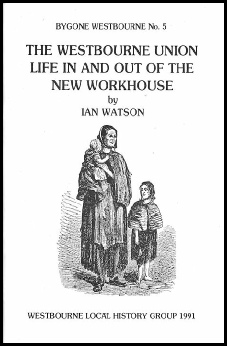
WESTBOURNE
A village history in West Sussex
PUBLICATIONS
Westbourne History Group
Bygone Series
No2. Village Schools 1819-
No9. The Bastards of Westbourne
No10. Westbourne’s War 1939-
No15. The Village Schools 1810-
No16. Westbourne and the Great War
No17. Tradespeople of Westbourne
Numbers 1 to 5 inclusive out of print, further information on details and costs visit:
www.westbournevillage.org
Home | Personal | Church | Scouts | Schools | Ambrose | Sketchbook | Workhouse | Census | Memories | Yesteryear | Publications | Village Website
 In 1835, Westbourne Parish and eleven others, each previously responsible for relieving its own poor, were combined into the new Westbourne Union. This was the result of the Poor Law Amendment Act of 1834.
In 1835, Westbourne Parish and eleven others, each previously responsible for relieving its own poor, were combined into the new Westbourne Union. This was the result of the Poor Law Amendment Act of 1834.
REASONS FOR CHANGE
The Elizabethan Poor Law had imposed on a parish two duties, operating through locally appointed overseers. The first duty was to support those unable to work including the sick and aged; the second duty was to provide work for those unable to find it for themselves.
As the eighteenth century grew older the cost of relief from rates levied on a parish basis rose considerably.
Mid C 18 £0.75 million
1803 £5.3 million
1813 £8 million
The growth of poverty was due to a variety of causes, the South of England suffering the most.
The Government was committed to reducing taxation. Income tax had been abolished in 1816 to be re imposed in 1842. The income of central government came mainly from taxes on commodities in mass demand:-
A Commission set up in 1832 by the Reformed Parliament to enquire into the operation of the Poor Laws concluded, quite erroneously in view of its lack of statistics, that the rise in demand for relief was due to the laziness of the “able bodied pauper”. Thus by denying him relief, rates could be reduced. This was the aim of the Poor Law Amendment Act.
An able bodied pauper would not receive relief unless he entered the workhouse. Life, in the workhouse was to be made so unpleasant that he would not enter. This was to be achieved by having dreary work, an unattractive but just adequate diet, silence at work, strict rules of conduct, no drink and the splitting up of families.
Published 1991 ISBN 0 9507496 4 8
THE WESTBOURNE UNION LIFE